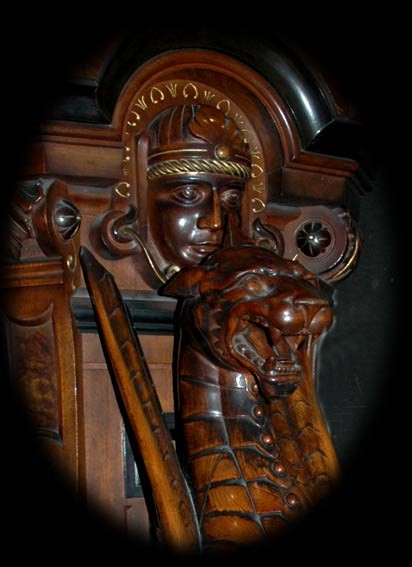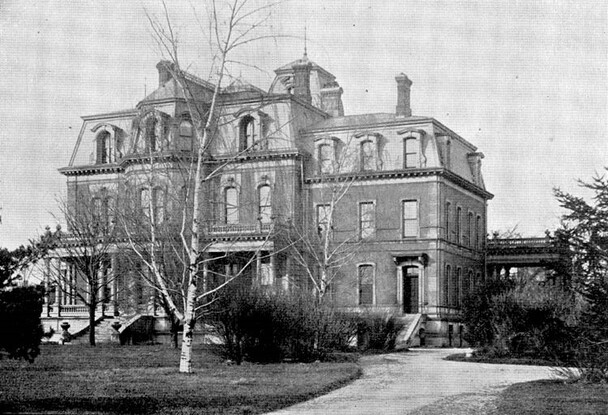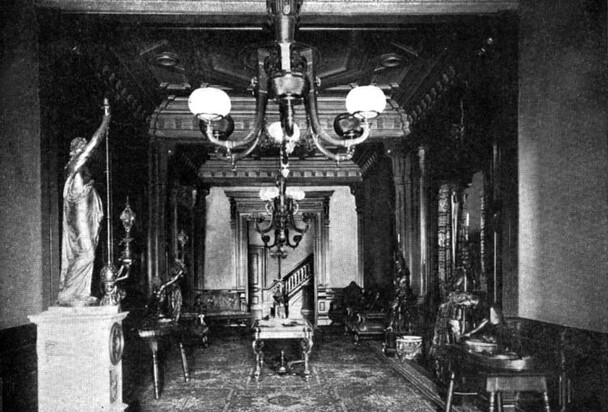William G. Fargo, co-founder of the Wells Fargo and American Express Company purchased 5.5 acres on Buffalo's semi-rural west side for his home. He was 50 years old in 1868 when he initiated construction of Buffalo's largest mansion; it was completed in 1872 at a cost of $600,000 ($8,645,000 in 2002 dollars). Another $100,000 ($1,240,000) was expended to furnish and decorate the 22,170 square-foot mansion.
Fargo's wife Anna died in 1890. The two surviving children lived elsewhere and the house stood vacant for 10 years.
Too expensive to maintain, with no buyer to be found, the mansion was demolished and the block cut into residential lots in 1901. The mansion and estate grounds were 30 years old.

Detail of the newell post from the Fargo Mansion, now on display at the Buffalo & Erie County Historical Society.
The Old Fargo Mansion
Sad Result of the Expressman's Hopes and Ambitions
Now Only a Heap of Ruins
Plans for Ancestral Home in Buffalo End Finally in "This Entire Block for Sale in Lots."
By William Drysdale
New York Times, May 25, 1901
The Fargo mansion was for many years one of the show places of Buffalo that strangers desired to see, and now that house lies a ragged heap of stones, both strangers and residents flock through the heavy stone gateways to see the grounds. The name Fargo is sufficient to bring to mind the Wells Fargo Express Company, and that is the man who created the handsome place that is now rapidly going to pieces under the hammers of a hundred workmen. It was his pet, and no doubt it is as well that he is not here to see it torn to pieces and made ready to go into the hands of strangers. Loving it as he evidently did, it would send cold chills down his spine to see the big sign that now ornaments one corner: "This entire block for sale in lots."
That is the present extent of the Fargo grounds and the block between Pennsyvania and Jersey Streets and West and Fargo Avenues. It is a block of land and nothing more, except a hole that was once a cellar, now filled with ragged blocks of granite that once made the foundation of a noble mansion of brick, and brownstone.
It goes without saying that the owner of that fine block in the heart of a growing city had money to indulge himself, so the Buffalonians of the time did not wonder unduly when Mr. Fargo began to buy up much of the vacant land surrounding his block. Not that he needed more land for his residence, but what he bought he could control, and neighbors could not crowd in too closely upon him. Almost in the centre of the block he built one of the largest and finest mansions that had been seen in this neighborhood, making the foundation of great lumps of granite, with a noble pile of brick and brownstone above, and two cupolas on the top.
Odd Features of the House
Some of the details seem odd enough now to those of us who really know, as we modestly think, just what a fine mansion ought to be. One room, for example, was a barber's shop, fitted up in imitiation of the real article, with the usual array of chairs and ill-smelling bottles and mirrors, and so on, so that the lord of the manor might go through the whole performance, in the role of customer, without quitting his own grounds. In the dining room were two large raised platforms, to be occupied by the bands that played while the family ate. Possibly one platform might have answered at a pinch, but by having two the music could come from different directions on different occasions.
Precious and handsome woods were brought from everywhere to ornament the mansion, and many were the artists employed to carve these woods into unique shapes. Choice were the mantels and gorgeous the mirrors that surmounted them, though not nearly as fine, in the owner's eyes as some of the other mirrors, because many others could be so very much larger.
The whole place, indeed, as it was in the days of its glory, was enough to raise a smile from our more modern standpoint, if one did not take trouble to consider that its owner lavished his own personality upon it because he loved it. Indeed he loved it, as I see by a thousand little evidences whenever I walk past it. Every shapely tree is an evidence of his love; every foot of what was until lately a beautiful lawn...To visit this dismantled place and think of the affection bestowed upon it, the pride that was taken in it, the vain expectations of its owner, is to take a sad and wholesome lesson in the uncertainty of human affairs... Now, if you please, "this entire block for sale in lots," and house and owner both in the ground...
Part of the old building has been incorporated in new buildings on other sites, and part of it lies in the cellar in a heap. Stray horses graze on the old man's beautiful lawns and boys play ball upon them. It is a common saying that trees grow while we sleep and these trees have indeed grown beautiful while their former owner sleeps a long sleep...
For much more information on William Fargo and his life in Buffalo, including rare photos of the interior of the Fargo mansion, see the 2-part series on "William Fargo:The Tycoon from Buffalo" by Jacek A. Wysocki in the Summer 2002 and Fall 2002 issues of Heritage Magazine.









